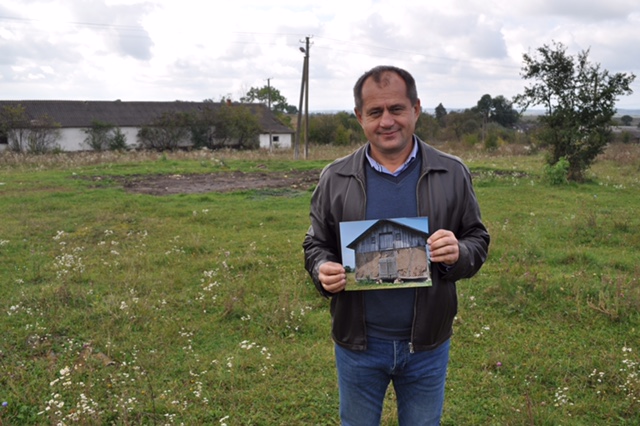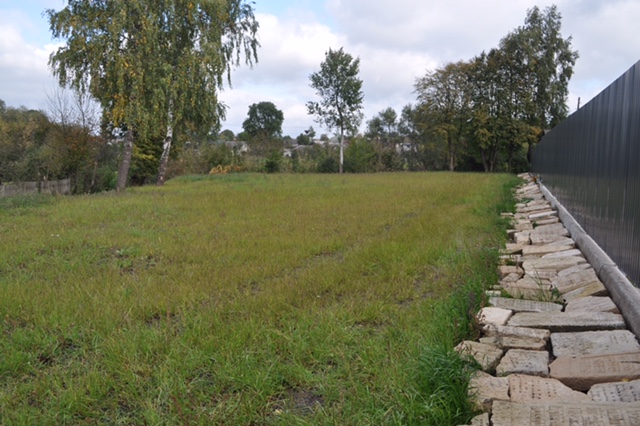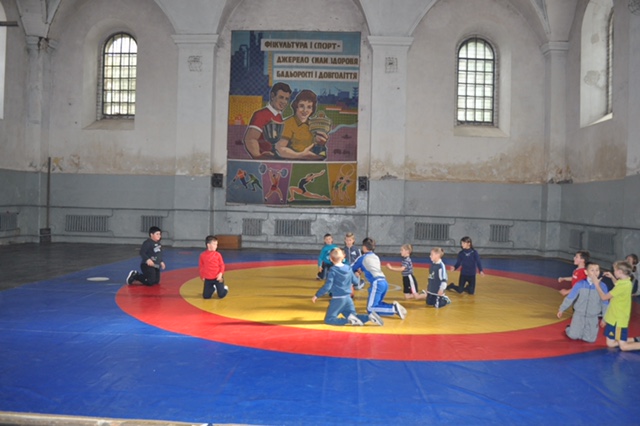Re-encountering the Jewish past in Ukraine
13 November 2017 – Jonathan Schaffer

Bogdan Stanislawski standing at the former site of a storehouse that had used Jewish headstones as its foundation, October 2017. Photo credit: Jonathan Schaffer
A thoughtful, though limited narrative prevails today of Jewish Americans returning to the lands of their ancestors in Eastern Europe. Articles abound, including in The New York Times recently, that follow a certain trajectory: a Jewish American boards a plane to find themselves in a strange land that time forgot. Upon arrival in a former shtetl (village) of family importance, now a mix of rundown pre-war structures and dystopian Soviet-era buildings, the Jewish American visits: 1) the desecrated and overgrown Jewish cemetery—stones are toppled or non-existent, buildings encroach or even cover the cemetery, the occasional cross or Christian shrine makes an appearance; 2) the former synagogue—if it exists at all, it has been re-purposed for current-day use; 3) the mass grave of the former Jewish inhabitants–typically in the nearby woods where they were shot at close range.
If there is any interaction with the locals, it’s with old “babushkas” who share stories of the Jews they once knew and who pepper their Ukrainian with otherworldly mentions of “Rosenbaums” and “Schneiders.” It’s astonishing to hear Jewish surnames spilling from the lips of elderly people in these remote places. The Jewish American departs with a head full of unshakable images of devastation, cruelty, and neglect.
I know this archetypal visit well, because I experienced it myself in 2010. While these articles convey authentic reflections of sorrow and loss, what concerns me is that no one revisits these places a second time after the rawness and immediacy have subsided in search of context and meaning in today’s world.
After my first visit in 2010 to the towns and villages of my ancestors in what is now Western Ukraine, I, too, struggled with what I had encountered. In 2016, I returned for a second visit which I chronicled in an essay for the National Council on Public History entitled “Recognition of the Jewish past in Western Ukraine: Changing for the better.” This time, my internalization of what I experienced was more measured. I focused on reconciling the past and present through a wider lens that included the reality of today.

Headstones repatriated to the Jewish cemetery in Obertyn, Ukraine, 2017. Image courtesy Jonathan Schaffer
In October 2017, I ventured to Ukraine once again. The catalyst for this visit was to witness the recent repatriation of Jewish headstones to a rededicated portion of the former Jewish cemetery in the village of Obertyn. As I had written in 2016, the headstones had been used as the foundation of a grain storehouse during the Soviet era. A local businessman named Bogdan Stanislawski, 48, who owns a commercial property on the former cemetery, has returned the stones to a prepared section of the cemetery at his own expense. And so, my mother, Susan, and I traveled to meet Bogdan and to learn more about the project which will likely include a fence, a memorial plaque, and a walkway.

The author’s mother, Susan, with an Obertyn woman who shared quince from her garden, October 2017. Photo credit: Jonathan Schaffer
I had seen photos and local news coverage of the rededicated section of the cemetery in Obertyn, but there’s nothing like experiencing progress firsthand. We met Bogdan at his sleek bakery-café in the larger town of Kolomyja before driving with him to the cemetery site in Obertyn. There, locals greeted us warmly as we marveled at the long row of headstones basking in the sunlight after so many years stacked under the storehouse. My mother developed an instant rapport with an older woman who lived directly across the street. After my mother inquired via our guide/interpreter, Tomasz Jankowski, about what she grew in her garden, this lovely woman raced home and returned with a bag full of quince freshly picked from her trees.
Bogdan explained that it had always troubled him that the cemetery wasn’t afforded any respect. He also grew up near the storehouse and knew what the supporting stones really were. It doesn’t matter whether his motivations behind the cemetery re-dedication are benevolent or commerce driven or both. Bogdan and I are just two years apart in age. He had as much to do with the Holocaust as I did. And while our perspectives may differ, we’re both seeking the same outcome in recognizing the Jewish past in Obertyn.

Classroom in Horodenka, where a student is holding up Someone Must Survive to Tell the World, by Tosia Szechter Schneider, October 2017. Photo credit: Jonathan Schaffer
We then drove to my late maternal grandfather’s hometown of Horodenka. We had arranged to meet with English-speaking children at the local high school in this town of 10,000 people. I’d expected a small group of students seated around a table, but my mother and I walked into a packed classroom. Our interest in meeting was not to lecture the students on their town’s Jewish past and the culpability of their ancestors; we simply wanted to interact with young people living in Horodenka today.
The students spoke English to varying degrees, and they were welcoming and polite. We carried on a lively exchange on lighter topics ranging from their favorite music to after-school chores to future career plans. When asked, they expressed familiarity with the Jewish cemetery and the former synagogue and its past: 2,500 Jews were crammed into the synagogue before being taken by truck close to the Dneister River where they were shot. We gave the class a copy of the memoirs of Tosia Szechter Schneider, a Holocaust survivor from Horodenka living in Atlanta. Their English teacher, Maria, said they looked forward to learning from her experience.
With one exception, none of the students had ever met anyone Jewish. As a result, they seemed to equate all Jews with Hasidic Jews. I was glad to provide them with a real-world connection to Jews which, in our case, meant two secular Jews from America. Perhaps our being there humanized the remaining Jewish places in their town that stand out as vestiges of a lost community from an increasingly distant past.
After the students had left, Maria asked if we could arrange a pen pal program. I was delighted at the prospect of students from my children’s school district in New Jersey corresponding with those from my grandfather’s hometown. Surely, my grandfather’s memories of Horodenka where his father and other family members and friends were executed during the first German “aktion” in December 1941 were defined by grief, anger, and loss. I honor this past, but I am also of a generation that can build bridges with the Ukrainian people living there today. If this interaction leads to a teenager in Horodenka walking by the synagogue and feeling compassion towards the Jews who once lived there and instills a greater sense of respect for the remaining Jewish sites, then I think my grandfather would approve.

Students exercising in the former synagogue in Horodenka, October 2017. Photo credit: Jonathan Schaffer
Before leaving Horodenka, I paid a quick visit to the former synagogue just around the corner from the school. The synagogue now serves as a gymnasium with a large wrestling mat on the main floor and basketball hoops hanging from the walls. The balcony where women once gathered to pray functions as a weight-lifting area. Unlike during my two previous visits, the former sanctuary was a sea of activity with elementary school children playing games and exercising with their teacher on the mat. If the synagogue had to be re-purposed, then I was glad to hear it filled with the laughter of children similar in age to my own two young boys back home.
I wouldn’t have been receptive to these moments of human connection on my first trip to Ukraine in 2010. Like other Jewish Americans, the overwhelming awfulness of standing at a mass grave of my people defined my initial visit, but that’s not where the story should end. Of course, there is no happy ending to the Holocaust. Nothing will change what happened. Yet, every time I return to Ukraine I see signs of progress toward greater recognition of the Jewish past in these faraway places. And every bridge we build with the people who live in these former shtetls makes us seem less faraway, too. At least, that is my hope.
~ Jonathan Schaffer is married with two young boys. By profession, he is a managing director at a tech-oriented IPO advisory and investor relations firm in New York City. He wishes he asked his grandparents more questions when they were alive. To learn more about Jonathan’s public history work, please visit: www.returntogalicia.com




Hi Jonathan,
I recently visited the Obertyn cemetery. It is an amazing memorial to the people who were killed in Obertyn during WW II and those who were buried in the cemetery. I highly recommend a visit. There is now a concrete path and many people have left mementos against the fence. I wish I had found your article before I left. This was my first time in Ukraine. We stayed in Kolomyia and visited Horodenka, Obertyn, Khotymry and Ivanivtsi in one day.
Hi Jeffrey,
Thank you for your comment and apologies on the much belated reply! I hope my experience was helpful as you reflect on yours. If you haven’t already, feel free to visit my site, http://www.returntogalicia.com, for pictures and video (including interviews) from Obertyn and other towns.
Thank you for your article. My grandfather was born in Obertyn. Is there a database of the headstones in English? I would like to try to find the headstones of my family (Schickler, Schikler, Reif, Schnabel, Baltuch and Winterfield.)